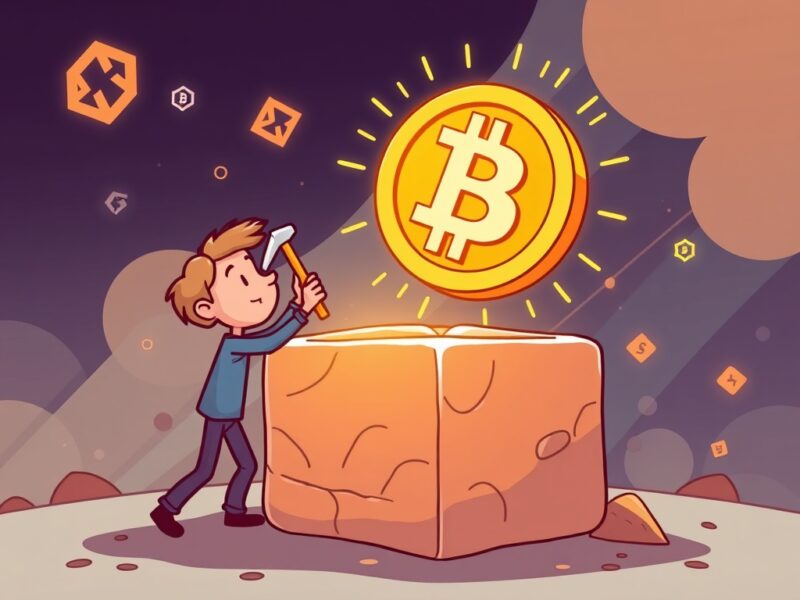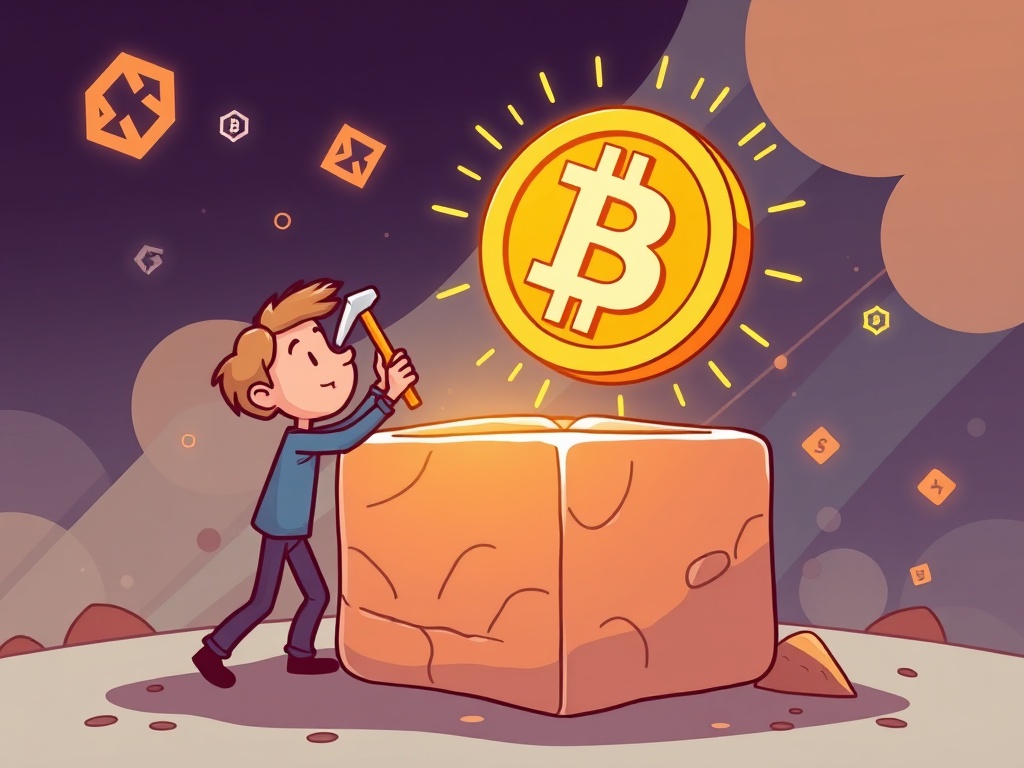Solo Bitcoin Miner Achieves Astounding 3.1 BTC Block Reward
0
0

BitcoinWorld

Solo Bitcoin Miner Achieves Astounding 3.1 BTC Block Reward
The world of cryptocurrency often highlights the massive operations of large mining farms, but every so often, an individual achievement reminds us of the decentralized spirit. Recently, a solo Bitcoin miner defied the odds, successfully mining a full Bitcoin block and securing a substantial reward.
This incredible feat occurred on August 17th, when the anonymous solo Bitcoin miner confirmed block 910,440 at approximately 10:19 UTC. This monumental effort yielded a remarkable 3.1 BTC, valued at an astounding $370,000 at the time. Data from blockchain explorer Mempool verified this rare event, sparking discussions across the crypto community and showcasing the unpredictable nature of cryptocurrency mining.
What Does it Take to Be a Solo Bitcoin Miner?
Mining Bitcoin, especially as a solo endeavor, requires significant computational power and an immense amount of luck. Miners compete globally to solve complex cryptographic puzzles. The first miner to find the solution gets to add a new block of transactions to the Bitcoin blockchain and earns the associated block reward. For an individual to achieve this without the collective power of a large mining pool is exceptionally rare, akin to winning a major lottery.
- High Hash Rate: A solo miner needs a substantial amount of hashing power, which is the speed at which a mining machine operates, to even have a slim chance against the global competition.
- Specialized Hardware: Application-Specific Integrated Circuit (ASIC) miners are essential for efficient Bitcoin mining. These machines are purpose-built for this highly specialized task.
- Luck Factor: Even with powerful hardware, the probability of a single miner discovering a block before thousands of others in pools is astronomically low.
This success story serves as a powerful reminder that while immensely difficult, individual triumph in cryptocurrency mining is still theoretically possible within the decentralized network.
Understanding the Block Reward and Bitcoin Halving
The current Bitcoin block reward is 3.125 BTC, following the halving event in April 2024. This solo miner’s payout reflects this new, reduced reward. Previously, the reward was 6.25 BTC. The halving mechanism is a programmed event that cuts the reward approximately every four years. This process is designed to control Bitcoin’s supply and ensure its scarcity, making each block reward even more valuable over time.
How rare is this achievement? Consider that the global Bitcoin network’s total hash rate is immense. A solo Bitcoin miner typically contributes a minuscule fraction of this power. Their success highlights the truly decentralized nature of Bitcoin, where even small participants have a theoretical chance, however slim. It’s a testament to the network’s robust design that such an event can occur, reinforcing the system’s integrity.
Is Solo Bitcoin Mining a Viable Path for Everyone?
While inspiring, attempting solo Bitcoin mining is generally not recommended for the average enthusiast due to the overwhelming odds and significant costs involved. The barriers to entry are substantial for individuals looking to compete against well-funded operations.
- High Equipment Costs: Purchasing powerful ASIC miners can run into thousands of dollars, representing a significant upfront investment.
- Electricity Consumption: These machines consume vast amounts of electricity, leading to very high operational costs that can quickly outweigh potential earnings.
- Low Probability of Success: Without joining a mining pool, the chances of earning a block reward are exceedingly low for most individuals, making it an economically unfeasible venture for many.
Most miners opt to join mining pools, which combine their hash rate to increase their collective chance of solving a block. The pool then distributes the digital currency reward proportionally to each participant’s contribution, offering a more consistent, albeit smaller, income stream.
The Impact and Future Outlook for Digital Currency Mining
This particular solo Bitcoin miner‘s success story has resonated widely, bringing attention to the unique and often challenging aspects of cryptocurrency mining. It underscores the allure of a potentially life-changing payout, even as the barriers to entry for solo mining remain incredibly high. For the broader digital currency ecosystem, such events reinforce the network’s resilience and its commitment to a decentralized structure, where anyone with the right equipment and immense luck can contribute and be rewarded.
The future of Bitcoin mining continues to evolve. As the network’s hash rate grows and halvings further reduce the block reward, efficiency and scale become increasingly important. However, the dream of a solo miner striking it rich persists, fueled by remarkable stories like this one. It’s a powerful narrative in the ongoing journey of decentralized finance and the enduring appeal of the digital currency landscape.
Summary: A Rare Triumph in Bitcoin Mining
The recent success of a solo Bitcoin miner securing a 3.1 BTC block reward is a truly remarkable event. It highlights the incredible potential, albeit rare, for individual achievement within the vast and competitive world of cryptocurrency mining. While the odds remain stacked against solo miners, this story serves as a compelling reminder of Bitcoin’s decentralized ethos and the enduring possibility of striking gold in the digital currency realm. It’s a testament to luck, persistence, and the raw power of the Bitcoin network.
Frequently Asked Questions (FAQs)
1. What is a solo Bitcoin miner?
A solo Bitcoin miner is an individual or entity that attempts to mine Bitcoin blocks independently, without joining a mining pool. They compete directly against the entire global network.
2. How much was the block reward this solo miner received?
The solo miner received 3.1 BTC, which was valued at approximately $370,000 at the time of the discovery.
3. Why is solo Bitcoin mining so rare?
Solo Bitcoin mining is rare because the network’s total hashing power is immense. An individual miner’s contribution is typically a tiny fraction of the global hash rate, making the probability of solving a block independently extremely low.
4. What is a Bitcoin halving?
A Bitcoin halving is a pre-programmed event that occurs approximately every four years, cutting the reward for mining new blocks by half. This mechanism controls the supply of new Bitcoin entering circulation.
5. Should I try solo Bitcoin mining?
For most individuals, solo Bitcoin mining is not recommended due to the high costs of specialized hardware, significant electricity consumption, and the extremely low probability of earning a block reward. Joining a mining pool is generally a more practical approach for those interested in cryptocurrency mining.
Did this incredible solo mining story inspire you? Share this article with your friends and fellow crypto enthusiasts on social media to spread the word about this rare achievement in the world of Bitcoin!
To learn more about the latest Bitcoin trends, explore our article on key developments shaping Bitcoin price action.
This post Solo Bitcoin Miner Achieves Astounding 3.1 BTC Block Reward first appeared on BitcoinWorld and is written by Editorial Team
0
0
 Manage all your crypto, NFT and DeFi from one place
Manage all your crypto, NFT and DeFi from one placeSecurely connect the portfolio you’re using to start.






